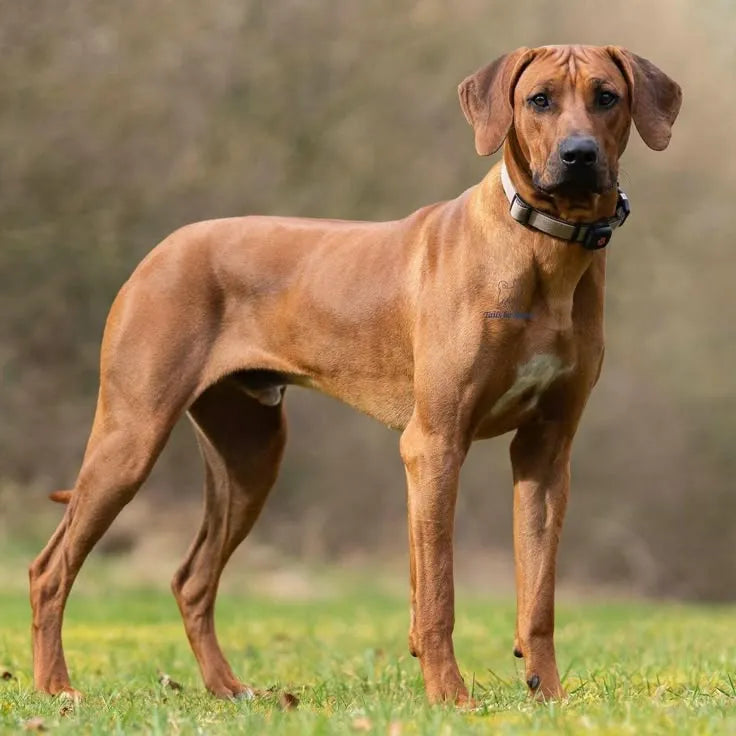Rhodesian Ridgeback
America’s Courageous and Athletic Hunter
1. Introduction to the Breed
The Rhodesian Ridgeback, securing the #43 spot in the 2024 American Kennel Club (AKC) rankings, is a courageous and athletic breed renowned for its distinctive ridge and loyal temperament. Known as the “African Lion Hound,” these powerful dogs excel as hunters, guard dogs, and devoted companions. Their sleek coat and independent nature make them ideal for active owners in rural or suburban homes, where their strength and protective instincts bring confidence and companionship.
2. History of the Breed
Originating in Southern Africa in the 19th century, Rhodesian Ridgebacks were bred by European settlers and indigenous Khoikhoi people, crossing native ridged dogs with European breeds like Great Danes and Bloodhounds. Developed to track and bay lions, they protected farms and hunted game. Recognized by the AKC in 1955, Ridgebacks gained U.S. popularity for their versatility in hunting, dog sports, and as family protectors. Their unique ridge and storied history as lion hunters have cemented their appeal.
3. Physical Characteristics
- Typical Size and Weight: Ridgebacks are large, standing 24–27 inches tall at the shoulder. Males weigh 85–90 pounds, while females range from 70–80 pounds, with a muscular, athletic build.
- Coat and Color: Their short, sleek coat is light to red wheaten, sometimes with white markings. The hallmark dorsal ridge of reversed hair runs along the spine. The coat sheds minimally.
- Distinctive Features: Ridgebacks have a broad head, deep-set eyes, and a strong muzzle. Their ridge, long legs, and fluid gait reflect their hunting prowess and elegant strength.
4. Personality Traits
Rhodesian Ridgebacks are confident, loyal, and independent, with a protective nature that makes them excellent guard dogs. They form strong bonds with families, showing affection with trusted members, but may be aloof with strangers or other pets, requiring socialization. Their high prey drive leads to chasing, and their calm yet alert demeanor suits experienced owners who provide structure. Ridgebacks are intelligent but strong-willed, needing mental and physical stimulation to prevent boredom-driven behaviors like chewing or digging.
5. Care Requirements
- Exercise Needs: Ridgebacks need 60–90 minutes of daily exercise, including running, hiking, or tracking games. Mental stimulation through scent work or puzzle toys keeps their sharp minds engaged.
- Grooming Needs: Their short coat requires weekly brushing with a firm brush to manage minimal shedding. Regular ear cleaning, nail trimming, and dental care prevent infections and maintain health.
- Dietary Considerations: A high-protein diet supports their muscular build, with foods containing glucosamine for joint health. Portion control prevents obesity, and fresh water is essential post-exercise.
6. Health and Lifespan
Rhodesian Ridgebacks have an average lifespan of 10–12 years. Common health issues include hip dysplasia, elbow dysplasia, hypothyroidism, and dermoid sinus (a congenital spinal condition). Regular vet checkups, joint screenings, and a healthy lifestyle mitigate risks. Owners should monitor for lameness, skin issues, or lethargy and ensure a balanced diet to support overall health. Genetic testing from breeders reduces hereditary concerns, particularly for dermoid sinus.
7. Training and Socialization
Ridgebacks are intelligent but independent, requiring consistent, positive reinforcement training with treats or play. Their strong-willed nature demands firm, confident leadership from experienced owners. Early socialization is critical to reduce wariness or aggression toward strangers or other animals. Teaching commands like “recall” and “stay” helps manage their prey drive. Activities like scent tracking, agility, or obedience training channel their energy effectively.
8. Ideal Home Environment
Rhodesian Ridgebacks thrive in homes with large, secure yards, ideal for rural or suburban settings where they can exercise and patrol. They suit active, experienced owners who enjoy outdoor activities like hiking or running. Supervision is needed with children or other pets due to their prey drive. Apartments can work if exercise needs are met, but a spacious environment is preferred. Owners should provide a secure, stimulating setting to prevent boredom or territorial behavior.
9. What’s the Best Toy for My Rhodesian Ridgeback?
Rhodesian Ridgebacks enjoy toys that suit their athletic build and hunting instincts, engaging their strength and sharp minds. Durable chew toys made of tough rubber withstand their powerful jaws, providing 20–30 minutes of chewing satisfaction, especially when stuffed with treats for mental stimulation. Large, sturdy balls for fetching tap into their tracking instincts, ideal for 20–30 minute outdoor sessions. Thick rope toys for tugging satisfy their physical strength, perfect for 15–20 minute interactive play with owners. Interactive puzzle toys with treat compartments challenge their intelligence, keeping them occupied indoors for 15–20 minutes. Avoid flimsy toys, as Ridgebacks can destroy them, risking choking. Rotate toys regularly and pair with scent games or training for engagement.
10. Adoption and Breeder Tips
Choose breeders affiliated with the Rhodesian Ridgeback Club of the United States, ensuring health clearances for hips, elbows, thyroid, and dermoid sinus. Visit the breeder to assess puppy health, meet parents for temperament insights, and confirm ethical practices, including socialization and clean facilities. Rescues like Ridgeback-specific organizations offer adoptable dogs, often with known histories. Avoid puppy mills, as Ridgebacks are prone to health issues if poorly bred. Ask about genetic testing, socialization, and the breeder’s experience with hunting or companion lines to ensure a healthy, well-adjusted dog.
